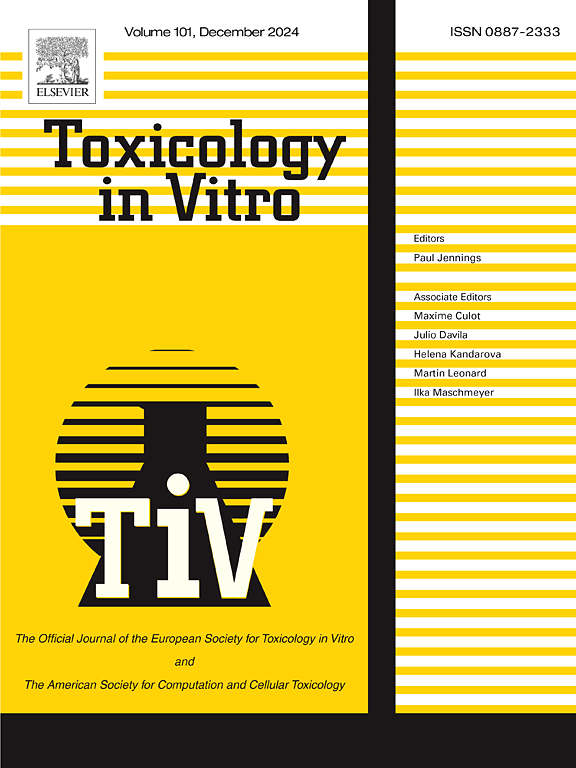Effects of 2,4-dichlorophenoxyacetic acid (2,4-D), isolated and in a formulated product, on the functional parameters of isolated rat liver mitochondria
IF 2.7
3区 医学
Q3 TOXICOLOGY
引用次数: 0
Abstract
2,4-Dichlorophenoxyacetic acid (2,4-D) is a widely used herbicide with known implications for environmental and biological systems. Previous studies indicate its potential to interact with cellular structures, potentially impacting cellular energy and metabolism. This study aimed to investigate the toxicological effects of this molecule on isolated rat liver mitochondria, evaluating both isolated and formulated 2,4-D to comprehend the differential impacts on mitochondrial function. Our investigations did not reveal significant induction of oxidative stress, mitochondrial swelling or impacts on mitochondrial respiration; however, exposure to both forms of 2,4-D affected mitochondrial membrane integrity and function in a concentration-dependent manner, notably impacting mitochondrial ATP levels and membrane potential. Comparatively, the formulated product showed toxicity at lower concentrations regarding interaction with membranes and ATP levels (from 0.4 μM on) and isolated 2,4-D showed toxicity at lower concentrations regarding membrane potential dissipation (from 10 μM on). Notably, the effects on ATP levels and membrane fluidity suggest interactions within the mitochondrial lipid bilayer. The findings highlight that excipients in the commercial formulation of 2,4-D potentially alter its effects, underlining the importance of evaluating not only active ingredients but also formulations.
2,4-二氯苯氧乙酸(2,4- d)对离体大鼠肝脏线粒体功能参数的影响
2,4-二氯苯氧乙酸(2,4- d)是一种广泛使用的除草剂,已知对环境和生物系统有影响。先前的研究表明,它可能与细胞结构相互作用,潜在地影响细胞能量和代谢。本研究旨在研究该分子对离体大鼠肝脏线粒体的毒理学作用,评估分离和配制的2,4- d对线粒体功能的不同影响。我们的研究没有发现氧化应激、线粒体肿胀或对线粒体呼吸的显著影响;然而,暴露于这两种形式的2,4- d以浓度依赖的方式影响线粒体膜的完整性和功能,特别是影响线粒体ATP水平和膜电位。相比之下,配制的产物在较低浓度下对膜相互作用和ATP水平(0.4 μM on)具有毒性,分离的2,4- d在较低浓度下对膜电位耗散(10 μM on)具有毒性。值得注意的是,对ATP水平和膜流动性的影响表明线粒体脂质双分子层内存在相互作用。研究结果强调了2,4- d商业配方中的赋形剂可能会改变其效果,强调了评估活性成分和配方的重要性。
本文章由计算机程序翻译,如有差异,请以英文原文为准。
求助全文
约1分钟内获得全文
求助全文
来源期刊

Toxicology in Vitro
医学-毒理学
CiteScore
6.50
自引率
3.10%
发文量
181
审稿时长
65 days
期刊介绍:
Toxicology in Vitro publishes original research papers and reviews on the application and use of in vitro systems for assessing or predicting the toxic effects of chemicals and elucidating their mechanisms of action. These in vitro techniques include utilizing cell or tissue cultures, isolated cells, tissue slices, subcellular fractions, transgenic cell cultures, and cells from transgenic organisms, as well as in silico modelling. The Journal will focus on investigations that involve the development and validation of new in vitro methods, e.g. for prediction of toxic effects based on traditional and in silico modelling; on the use of methods in high-throughput toxicology and pharmacology; elucidation of mechanisms of toxic action; the application of genomics, transcriptomics and proteomics in toxicology, as well as on comparative studies that characterise the relationship between in vitro and in vivo findings. The Journal strongly encourages the submission of manuscripts that focus on the development of in vitro methods, their practical applications and regulatory use (e.g. in the areas of food components cosmetics, pharmaceuticals, pesticides, and industrial chemicals). Toxicology in Vitro discourages papers that record reporting on toxicological effects from materials, such as plant extracts or herbal medicines, that have not been chemically characterized.
 求助内容:
求助内容: 应助结果提醒方式:
应助结果提醒方式:


